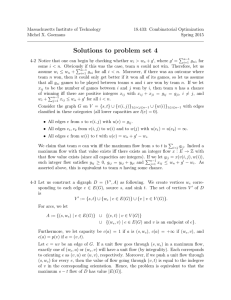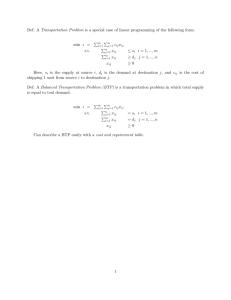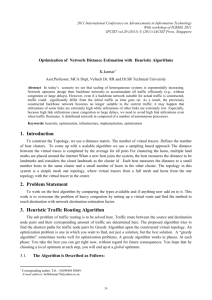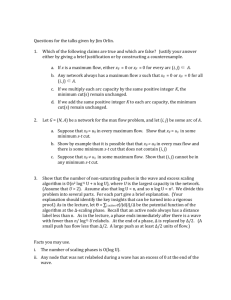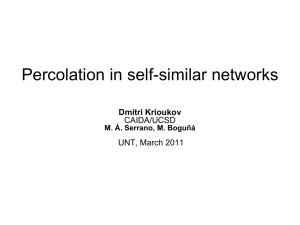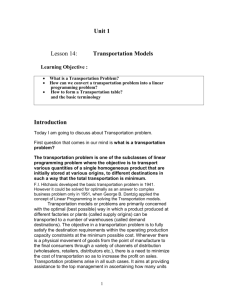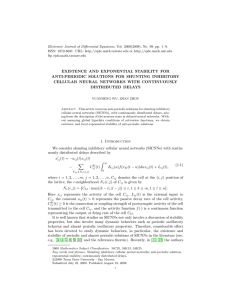Electronic Journal of Differential Equations, Vol. 2009(2009), No. 41, pp.... ISSN: 1072-6691. URL: or
advertisement
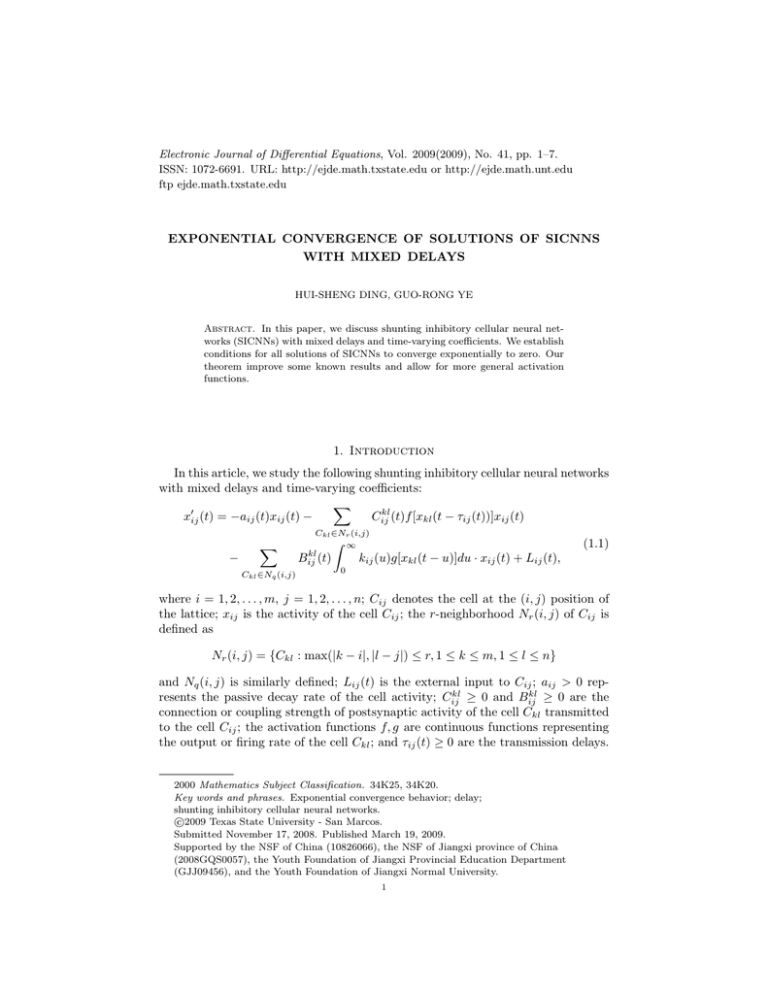
Electronic Journal of Differential Equations, Vol. 2009(2009), No. 41, pp. 1–7.
ISSN: 1072-6691. URL: http://ejde.math.txstate.edu or http://ejde.math.unt.edu
ftp ejde.math.txstate.edu
EXPONENTIAL CONVERGENCE OF SOLUTIONS OF SICNNS
WITH MIXED DELAYS
HUI-SHENG DING, GUO-RONG YE
Abstract. In this paper, we discuss shunting inhibitory cellular neural networks (SICNNs) with mixed delays and time-varying coefficients. We establish
conditions for all solutions of SICNNs to converge exponentially to zero. Our
theorem improve some known results and allow for more general activation
functions.
1. Introduction
In this article, we study the following shunting inhibitory cellular neural networks
with mixed delays and time-varying coefficients:
X
kl
x0ij (t) = −aij (t)xij (t) −
Cij
(t)f [xkl (t − τij (t))]xij (t)
−
Ckl ∈Nr (i,j)
Z ∞
kl
Bij (t)
kij (u)g[xkl (t
0
Ckl ∈Nq (i,j)
X
(1.1)
− u)]du · xij (t) + Lij (t),
where i = 1, 2, . . . , m, j = 1, 2, . . . , n; Cij denotes the cell at the (i, j) position of
the lattice; xij is the activity of the cell Cij ; the r-neighborhood Nr (i, j) of Cij is
defined as
Nr (i, j) = {Ckl : max(|k − i|, |l − j|) ≤ r, 1 ≤ k ≤ m, 1 ≤ l ≤ n}
and Nq (i, j) is similarly defined; Lij (t) is the external input to Cij ; aij > 0 repkl
kl
resents the passive decay rate of the cell activity; Cij
≥ 0 and Bij
≥ 0 are the
connection or coupling strength of postsynaptic activity of the cell Ckl transmitted
to the cell Cij ; the activation functions f, g are continuous functions representing
the output or firing rate of the cell Ckl ; and τij (t) ≥ 0 are the transmission delays.
2000 Mathematics Subject Classification. 34K25, 34K20.
Key words and phrases. Exponential convergence behavior; delay;
shunting inhibitory cellular neural networks.
c
2009
Texas State University - San Marcos.
Submitted November 17, 2008. Published March 19, 2009.
Supported by the NSF of China (10826066), the NSF of Jiangxi province of China
(2008GQS0057), the Youth Foundation of Jiangxi Provincial Education Department
(GJJ09456), and the Youth Foundation of Jiangxi Normal University.
1
2
H.-S. DING, G.-R. YE
EJDE-2009/41
Recall that in 1990s, Bouzerdoum and Pinter [1, 2, 3] introduced and analyzed
the networks commonly called shunting inhibitory cellular neural networks (SICNNs). Now, SICNNs have been extensively applied in psychophysics, speech, perception, robotics, adaptive pattern recognition, vision, and image processing (see,
e.g., [4, 5] and references therein).
It is well known that analysis of dynamic behaviors is very important for design
of neural networks. Therefore, there has been of great interest for many authors to
study all kinds of dynamic behaviors for SICNNs and its variants (see, e.g., [6, 11,
7, 8, 13, 12, 9, 10]). Especially, there are many interesting and important works
about exponential convergence behavior of solutions to SICNNs. For example, in
[13], the authors studied the following SICNNs with delays
X
kl
x0ij (t) = −aij (t)xij (t) −
Cij
(t)f [xkl (t − τ (t))]xij (t) + Lij (t),
(1.2)
Ckl ∈Nr (i,j)
where i = 1, 2, . . . , m, j = 1, 2, . . . , n, and established a theorem which ensure that
all the solutions of (1.2) converge exponentially to zero. Also, in [7], the authors
considered the same problem for the the following SICNNs with distributed delays
Z ∞
X
0
kl
xij (t) = −aij (t)xij (t) −
Cij (t)
kij (u)f [xkl (t − u)]du · xij (t) + Lij (t),
0
Ckl ∈Nr (i,j)
where i = 1, 2, . . . , m, j = 1, 2, . . . , n. In addition, the authors in [8] studied the
convergence behavior of solutions for the SICNNs (1.1).
In [7, 8, 13], the activity functions f and g are assumed to be bounded. Recently,
in [11], the assumption is weakened into
(H0) There exist constants m ≥ 1, n ≥ 1, Lf and Lg such that for all u ∈ R,
|f (u)| ≤ Lf |u|m ,
|g(u)| ≤ Lg |u|n .
In this paper, we allow for more general activity functions f and g; i.e., we only
assume that
(H1) f and g are continuous functions on R.
In addition, we do not need the restrictive condition used in [11] (see remark 2.3).
Throughout this paper, for i = 1, 2, . . . , m, j = 1, 2, . . . , n, kij : [0, +∞) → R are
kl
kl
continuous integrable functions, aij , Cij
, Bij
, τij are continuous functions, and Lij
are continuous bounded functions. Moreover, for real functions u(t) and v(t), we
write u(t) = O(v(t)) if there exists a constant M ≥ 0 such that for some N > 0,
|u(t)| ≤ M |v(t)|,
∀t ≥ N.
Since f and g are continuous functions, we define the following functions on [0, +∞):
F (x) = max |f (t)|,
|t|≤x
G(x) = max |g(t)|.
|t|≤x
2. Main results
In the proof of our results, we will use the following assumptions:
(H2) There exist constants η > 0 and λ > 0 such that
Z ∞
X
X
kl
kl
[λ − aij (t)] +
Cij
(t)F (β) +
Bij
(t)G(β)
|kij (u)|du < −η,
Ckl ∈Nr (i,j)
Ckl ∈Nq (i,j)
0
EJDE-2009/41
EXPONENTIAL CONVERGENCE
3
for all t > 0, i ∈ {1, 2, . . . , m} and j ∈ {1, 2, . . . , n}, where
β=
max(i,j) {supt≥0 |Lij (t)|}
.
η
(H3) Lij (t) = O(e−λt ), i = 1, 2, . . . , m, j = 1, 2, . . . , n.
Lemma 2.1. Assume that (H1) and (H2) hold. Then, for every solution
{xij (t)} = (x11 (t), . . . , x1n (t), . . . , xi1 (t), . . . , xin (t), . . . , xm1 (t), . . . , xmn (t)),
of (1.1) with initial condition sup−∞<s≤0 max(i,j) |xij (s)| < β, there holds
|xij (t)| ≤ β,
(2.1)
for all t ∈ R and ij ∈ {11, 12, . . . , mn}.
Proof. Assume that (2.1) does not hold. Then there exist i0 ∈ {1, 2, . . . , m} and
j0 ∈ {1, 2, . . . , n} such that
{t > 0 : |xi0 j0 (t)| > β} =
6 ∅.
(2.2)
For each k ∈ {1, 2, . . . , m} and l ∈ {1, 2, . . . , n}, let
Tkl
(
inf{t > 0 : |xkl (t)| > β} {t > 0 : |xkl (t)| > β} =
6 ∅,
=
+∞
{t > 0 : |xkl (t)| > β} = ∅.
Then Tkl > 0 and
|xkl (t)| ≤ β,
∀t ≤ Tkl , k = 1, 2, . . . , m, l = 1, 2, . . . , n.
(2.3)
We denote T0 = Tij = min(k,l) Tkl , where i ∈ {1, 2, . . . , m} and j ∈ {1, 2, . . . , n}. In
view of (2.2), we have 0 < T0 < +∞. It follows from (2.3) that
|xkl (t)| ≤ β,
∀t ≤ T0 , k = 1, 2, . . . , m, l = 1, 2, . . . , n.
(2.4)
In addition, noticing that T0 = inf{t > 0 : |xij (t)| > β}, we obtain
|xij (T0 )| = β,
D+ (|xij (s)|)|s=T0 ≥ 0.
(2.5)
4
H.-S. DING, G.-R. YE
EJDE-2009/41
Combing (H2), (2.4) and (2.5), we have
D+ (|xij (s)|)|s=T0
n
= sgn(xij (T0 )) − aij (T0 )xij (T0 ) −
X
kl
Cij
(T0 )f [xkl (T0 − τij (T0 ))]xij (T0 )
Ckl ∈Nr (i,j)
−
X
kl
Bij
(T0 )
∞
Z
0
Ckl ∈Nq (i,j)
X
≤ −aij (T0 ) · |xij (T0 )| +
+
X
o
kij (u)g[xkl (T0 − u)]du · xij (T0 ) + Lij (T0 )
Ckl ∈Nr (i,j)
Z ∞
kl
Bij
(T0 )G(β)
|kij (u)|du · |xij (T0 )| + |Lij (T0 )|
0
Ckl ∈Nq (i,j)
≤
n
kl
Cij
(T0 )F (β) · |xij (T0 )|
X
− aij (T0 ) +
kl
Cij
(T0 )F (β)
Ckl ∈Nr (i,j)
+
X
kl
Bij
(T0 )G(β)
Z
∞
o
|kij (u)|du · β + |Lij (T0 )|
0
Ckl ∈Nq (i,j)
< −η · β + |Lij (T0 )|
= − max{sup |Lij (t)|} + |Lij (T0 )| ≤ 0.
(i,j)
t≥0
This contradicts D+ (|xij (s)|)|s=T0 ≥ 0. Thus, (2.1) holds.
Theorem 2.2. Let (H1)–(H3) hold. Then, for every solution
{xij (t)} = (x11 (t), . . . , x1n (t), . . . , xi1 (t), . . . , xin (t), . . . , xm1 (t), . . . , xmn (t))
of (1.1) with initial condition sup−∞<s≤0 max(i,j) |xij (s)| < β, there holds
xij (t) = O(e−λt ),
ij = 11, 12, . . . , mn.
Proof. It follows from (H3) that there exist constants M > 0 and T > 0 such that
1
(2.6)
|Lij (t)| < ηM e−λt , ∀t ≥ T, ij = 11, 12, . . . , mn.
2
Let {xij (t)} = (x11 (t), . . . , x1n (t), . . . , xi1 (t), . . . , xin (t), . . . , xm1 (t), . . . , xmn (t)) be
a solution of (1.1) with initial condition sup−∞<s≤0 max(i,j) |xij (s)| < β.
Set
Vij (t) = max{eλs |xij (s)|}, ij = 11, 12, . . . , mn.
s≤t
It is easy to prove that each Vij (t) is continuous. For any given t0 ≥ T and
ij ∈ {11, 12, . . . , mn}, we consider three cases.
Case (i) Vij (t0 ) > eλt0 |xij (t0 )|. It follows form the continuity of xij (t) that there
exists δ1 > 0 such that
eλt |xij (t)| < Vij (t0 ),
∀t ∈ (t0 , t0 + δ1 ).
Thus, we can conclude
Vij (t) = Vij (t0 ),
λt0
Case (ii) Vij (t0 ) = e
δ2 > 0 such that
∀t ∈ (t0 , t0 + δ1 ).
|xij (t0 )| < M . Also, by the continuity of xij (t), there exists
eλt |xij (t)| < M,
∀t ∈ (t0 , t0 + δ2 ).
EJDE-2009/41
EXPONENTIAL CONVERGENCE
5
Therefore,
∀t ∈ (t0 , t0 + δ2 ).
Vij (t) < M,
λt0
Case (iii) Vij (t0 ) = e |xij (t0 )| ≥ M . By Lemma 2.1, |xkl (t)| ≤ β for all t ∈ R
and kl ∈ {11, 12, . . . , mn}. In view of this and (H2), (2.6), we have
D+ (eλs |xij (s)|)|s=t0
n
= λeλt0 |xij (t0 )| + eλt0 sgn(xij (t0 )) − aij (t0 )xij (t0 )
X
kl
−
Cij
(t0 )f [xkl (t0 − τij (t0 ))]xij (t0 )
Ckl ∈Nr (i,j)
−
X
kl
Bij
(t0 )
Z
∞
o
kij (u)g[xkl (t0 − u)]du · xij (t0 ) + Lij (t0 )
0
Ckl ∈Nq (i,j)
n
≤ eλt0 |xij (t0 )| λ − aij (t0 ) +
+
X
kl
Bij
(t0 )G(β)
X
Z
Ckl ∈Nr (i,j)
∞
o 1
|kij (u)|du + ηM
2
0
Ckl ∈Nq (i,j)
kl
Cij
(t0 )F (β)
1
1
≤ eλt0 |xij (t0 )| · (−η) + ηM ≤ −ηM + ηM
2
2
1
= − ηM < 0.
2
Since D+ (eλs |xij (s)|)|s=t0 < 0, there exists δ3 > 0 such that
eλt |xij (t)| < eλt0 |xij (t0 )| = Vij (t0 ),
∀t ∈ (t0 , t0 + δ3 ).
Then, we conclude that
Vij (t) = Vij (t0 ),
∀t ∈ (t0 , t0 + δ3 ).
In summary, for any given ij ∈ {11, 12, . . . , mn}, for all t0 ≥ T , there exists δ =
min{δ1 , δ2 , δ3 } > 0 such that
Vij (t) ≤ max{Vij (t0 ), M },
∀t ∈ (t0 , t0 + δ).
0
Now, take t0 = T . Then there exists δ > 0 such that
∀t ∈ (T, T + δ 0 ).
Vij (t) ≤ max{Vij (T ), M },
Since Vij is continuous, we have
∀t ∈ (T, T + δ 0 ].
Vij (t) ≤ max{Vij (T ), M },
Take t0 = T + δ 0 . Then there exists δ 00 > 0 such that
Vij (t) ≤ max{Vij (T + δ 0 ), M } ≤ max{Vij (T ), M },
∀t ∈ (T + δ 0 , T + δ 0 + δ 00 ).
Then
Vij (t) ≤ max{Vij (T ), M },
∀t ∈ (T, T + δ 0 + δ 00 ).
Continuing the above step, at last, we get a maximal interval (T, αij ) such that
Vij (t) ≤ max{Vij (T ), M },
∀t ∈ (T, αij ).
Also, we have αij = +∞. In fact, if αij < +∞, then we have
Vij (t) ≤ max{Vij (T ), M },
∀t ∈ (T, αij ].
6
H.-S. DING, G.-R. YE
EJDE-2009/41
Take t0 = αij . Then there exists δ ∗ > 0 such that
Vij (t) ≤ max{Vij (T ), M },
∀t ∈ (T, αij + δ ∗ ).
This is a contradiction. Therefore,
Vij (t) ≤ max{Vij (T ), M },
∀t > T.
It follows that
eλt |xij (t)| ≤ max{Vij (T ), M },
whichimplies xij (t) = O(e−λt ).
∀t > T,
Remark 2.3. In [11], it is assume that β < 1. But in Theorem 2.2, we do not need
this condition. In addition, it is not difficult to show that Theorem [11, Theorem
2.1] is a corollary of Theorem 2.2.
3. Examples
In this section, we give an example to illustrate our results.
Example 3.1. Consider the SICNNs:
X
kl
x0ij (t) = −aij (t)xij (t) −
Cij
(t)f [xkl (t − τij (t))]xij (t) + Lij (t),
(3.1)
Ckl ∈N1 (i,j)
where i = 1, 2, 3, j = 1, 2, 3, τij (t) = | 21 t sin(i + j)t|, f (x) = ex ,
a11 (t) a12 (t) a13 (t)
5 + sin2 t 5 + | sin t| 7 + sin t
a21 (t) a22 (t) a23 (t) = 6 + sin t 7 + | sin t| 6 + sin t ,
a31 (t) a32 (t) a33 (t)
7 + sin t
8 + sin t 8 + sin t
0.1| sin t| 0.1 sin2 t 0.2| sin t|
c11 (t) c12 (t) c13 (t)
c21 (t) c22 (t) c23 (t) =
,
0
0.2 sin2 t
0
2
2
c31 (t) c32 (t) c33 (t)
0.1 sin t 0.1| sin t| 0.2 sin t
1 −t
L11 (t) L12 (t) L13 (t)
e−2t 2e−2t
2e
L21 (t) L22 (t) L23 (t) = e−2t e−t e−2t .
L31 (t) L32 (t) L33 (t)
e−2t e−t e−2t
Obviously, (H1) holds. By some calculations, it is easy to obtain that for all t ∈ R,
X
kl
aij (t) ≥ 5.
Cij
(t) ≤ 1.
Ckl ∈N1 (i,j)
In addition,
max{sup |Lij (t)|} = 2,
(i,j)
F (x) = ex .
t≥0
Let λ = 0.2 and η = 2. Then β = 1 and
X
kl
[λ − aij (t)] +
Cij
(t)F (β) ≤ 0.2 − 5 + e < −2 = −η,
Ckl ∈N1 (i,j)
for all t > 0, i = 1, 2, 3 and j = 1, 2, 3. Therefore, (H2) holds.
It is easy to verify that (H3) holds for λ = 0.2. Now, by Theorem 2.2, all the
solutions of (3.1) with initial condition
sup
max |xij (s)| < 1
−∞<s≤0 (i,j)
converge exponentially to zero when t → +∞.
EJDE-2009/41
EXPONENTIAL CONVERGENCE
7
Remark 3.2. In the above example, f is neither bounded nor satisfies (H0). Therefore, the results in [11, 7, 13, 8] can not be applied to this equation.
References
[1] A. Bouzerdoum, R. B. Pinter; Analysis and analog implementation of directionally sensitive shunting inhibitory cellular neural networks, in: Visual Information Processing: From
Neurons to Chips, in: SPIE, vol. 1473, (1991) 29–38.
[2] A. Bouzerdoum, R. B. Pinter; Nonlinear lateral inhibition applied to motion detection in
the fly visual system, in: R.B. Pinter, B. Nabet (Eds.), Nonlinear Vision, CRC Press, Boca
Raton, FL, (1992) 423–450.
[3] A. Bouzerdoum, R. B. Pinter; Shunting inhibitory cellular neural networks: Derivation and
stability analysis, IEEE Trans. Circuits Syst. 1 40 (1993) 215–221.
[4] H. N. Cheung, A. Bouzerdoum, W. Newland; Properties of shunting inhibitory cellular neural
networks for colour image enhancement, Information Processing, 6th International Conference
on Volume 3, (1999) 1219–1223.
[5] T. Hammadou, A. Bouzerdoum; Novel image enhancement technique using shunting inhibitory cellular neural networks, Consumer Electronics, ICCE. International Conference on
2001, 284–285.
[6] H. S. Ding, J. Liang, T. J. Xiao; Existence of almost periodic solutions for SICNNs with
time-varying delays, Physics Letters A 372 (2008), 5411–5416.
[7] Y. Li, H. Meng, Q. Zhou; Exponential convergence behavior of shunting inhibitory cellular neural networks with time-varying coefficients, Journal of Computational and Applied
Mathematics 216 (2008), 164–169.
[8] Y. Li, L. Huang; Exponential convergence behavior of solutions to shunting inhibitory cellular neural networks with delays and time-varying coefficients, Mathematical and Computer
Modelling 48 (2008), 499–504.
[9] B. Liu; Almost periodic solutions for shunting inhibitory cellular neural networks without
global Lipschitz activation functions, Journal of Computational and Applied Mathematics
203 (2007), 159–168.
[10] B. Liu, L. Huang; Almost periodic solutions for shunting inhibitory cellular neural networks
with time-varying delays, Applied Mathematics Letters, 20 (2007), 70–74.
[11] B. Liu; New convergence behavior of solutions to shunting inhibitory cellular neural networks
with unbounded delays and time-varying coefficients, Applied Mathematical Modelling 33
(2009), 54–60.
[12] B. Liu; Stability of shunting inhibitory cellular neural networks with unbounded time-varying
delays, Applied Mathematics Letters, in press.
[13] H. Meng, Y. Li; New convergence behavior of shunting inhibitory cellular neural networks
with time-varying coefficients, Applied Mathematics Letters 21 (2008), 717–721.
College of Mathematics and Information Science, Jiangxi Normal University, Nanchang, Jiangxi 330022, China
E-mail address, Ding: dinghs@mail.ustc.edu.cn
E-mail address, Ye: yeguorong2006@sina.com
